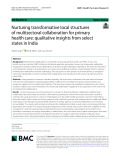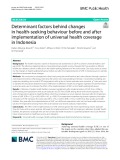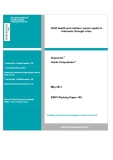
Essential primary health services
-
Multisectoral collaboration is essential for advancing primary health care (PHC). In low- and middle-income countries (LMICs), limited institutional capacities, governance issues, and inadequate stakeholder engagement impede multisectoral collaboration. India faces similar challenges, especially at the meso-level (districts and subdistricts).
 15p
15p  vishanshan
vishanshan
 27-06-2024
27-06-2024
 2
2
 1
1
 Download
Download
-
The health insurance system in Indonesia was transformed in 2014 to achieve universal health coverage (UHC). The effective implementation of essential primary health services through UHC has resulted inefficient healthcare utilisation, which is reflected in the health-seeking behaviour of the community
 21p
21p  viferrari
viferrari
 28-11-2022
28-11-2022
 13
13
 2
2
 Download
Download
-
Taking experiences of low resource setting into account, upgrading the quality and coverage of safe motherhood services (including neonatal care) will have the largest payoff in averting deaths and reducing disability among women and children in Bangladesh. For scaling up of these tasks, building a functioning primary healthcare system from community level to the first referral-level facilities is essential. Particular emphasis should be placed on developing human resources for health (HRH) in this sector, e.g.
 36p
36p  nhamnhiqa
nhamnhiqa
 01-03-2013
01-03-2013
 37
37
 1
1
 Download
Download
-
The health system is composed of the public sector, the for-profit private sector and the non-profit private sector. Health care services are provided mainly through the public sector network (NHS), which relies on 1277 health facilities (HF), organized in 4 levels, with a total of 15 877 beds6 and around 26 000 health workers (Table 4). Level I offers essential primary care services through 1224 HF (urban and rural health centres and health posts) representing 96% of all national HF.
 30p
30p  nhamnhiqa
nhamnhiqa
 01-03-2013
01-03-2013
 47
47
 1
1
 Download
Download
-
Governments in developing countries need to spend more money on essential public services if they are to have a serious impact on poverty. Take the United Nations Millennium Development Goals (MDGs), a set of targets for halving extreme poverty, providing universal primary education, halting the spread of HIV and AIDS and much more by 2015. Ambitious, yes, but achievable. To meet many of the MDGs, governments will need to hire more public sector employees, from teachers and doctors to agricultural extension workers.
 0p
0p  bin_pham
bin_pham
 06-02-2013
06-02-2013
 36
36
 3
3
 Download
Download
-
Governments should take a health systems approach when initiating and scaling-up comprehensive cervical cancer prevention and control programmes to avoid establishing stand-alone, disease-specific initiatives and to ensure long-term sustainability.
 9p
9p  taisaokhongthedung
taisaokhongthedung
 09-01-2013
09-01-2013
 61
61
 1
1
 Download
Download
-
Disparities in access to essential basic services, such as sanitation, clean water, health, education and access to the judiciary system, are fundamental inequities that can produce lifelong inequalities and deep-seated feelings of injustice. These inequities extend to things like access to information: while access to communication technologies, including the internet, may seem like a luxury, in reality it means that while most young people in developed countries, and the wealthier young people in poor countries, can obtain the information they seek, others cannot (see Figure 1).
 47p
47p  chiecxedien
chiecxedien
 02-01-2013
02-01-2013
 38
38
 2
2
 Download
Download
-
In addition to the effect this may have on the woman, this could damage staff morale and is a serious challenge to recruitment and retention of midwives whose primary professional motivation is to care for women22. Looking to the maternity service of 2020, it is likely that the number of women with complex medical and obstetric conditions will continue to rise.
 0p
0p  le_minh_nha
le_minh_nha
 18-12-2012
18-12-2012
 91
91
 6
6
 Download
Download
-
Vertical integration. Although the delivery of health care is concentrated in the vertically integrated medical care sector (organized around primary, secondary, and tertiary care), many other essential child health service programs are located in the public and population health sectors (Women, Infants, and Children, or WIC; Head Start; and Early Head Start).
 0p
0p  connicquy
connicquy
 14-12-2012
14-12-2012
 57
57
 1
1
 Download
Download
-
achieve universal primary education (Mdg 2). Gender parity in education is still to be achieved. It is essential because educated girls and women improve prospects for the whole family, helping to break the cycle of poverty. In Africa, for example, children whose mothers have been educated for at least five years are 40% more likely to live beyond the age of five. Schools can serve as a point of contact for women and children, allowing health-related information to be shared, services offered and health literacy promoted. ...
 8p
8p  connhobinh
connhobinh
 10-12-2012
10-12-2012
 45
45
 1
1
 Download
Download
-
To monitor provider use of language services, health plans are requiring that providers follow plan-specific processes to obtain language services, such as calling an 800 number to receive telephonic interpretation. However, it is unclear how plans will monitor providers to determine if they are using these services when appropriate. Staff at one health plan indicated that enrollee grievance filings will be the plan’s primary method for monitoring compliance. Importance of Collaboration Between Stakeholders. Collaboration between stakeholders has been essential to this effort.
 125p
125p  quygia123
quygia123
 02-11-2012
02-11-2012
 39
39
 3
3
 Download
Download
CHỦ ĐỀ BẠN MUỐN TÌM























